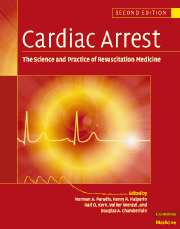Book contents
- Frontmatter
- Contents
- List of contributors
- Foreword
- Preface
- Part I Introduction
- Part II Basic science
- Part III The pathophysiology of global ischemia and reperfusion
- Part IV Therapy of sudden death
- Part V Postresuscitation disease and its care
- 47 Postresuscitation syndrome
- 48 Prevention and therapy of postresuscitation myocardial dysfunction
- 49 Prevention of postresuscitation neurologic dysfunction and injury by the use of therapeutic mild hypothermia
- 50 Postresuscitation neurologic prognostication and declaration of brain death
- 51 Bringing it all together: brain-oriented postresuscitation critical care
- Part VI Special resuscitation circumstances
- Part VII Special issues in resuscitation
- Index
49 - Prevention of postresuscitation neurologic dysfunction and injury by the use of therapeutic mild hypothermia
from Part V - Postresuscitation disease and its care
Published online by Cambridge University Press: 06 January 2010
- Frontmatter
- Contents
- List of contributors
- Foreword
- Preface
- Part I Introduction
- Part II Basic science
- Part III The pathophysiology of global ischemia and reperfusion
- Part IV Therapy of sudden death
- Part V Postresuscitation disease and its care
- 47 Postresuscitation syndrome
- 48 Prevention and therapy of postresuscitation myocardial dysfunction
- 49 Prevention of postresuscitation neurologic dysfunction and injury by the use of therapeutic mild hypothermia
- 50 Postresuscitation neurologic prognostication and declaration of brain death
- 51 Bringing it all together: brain-oriented postresuscitation critical care
- Part VI Special resuscitation circumstances
- Part VII Special issues in resuscitation
- Index
Summary
This book chapter is dedicated to Peter Safar, the father of modern resuscitation, and world leading pioneer in the field of therapeutic hypothermia.
Introduction
The history of induced hypothermia began in the 1950s with elective moderate hypothermia of the brain, introduced under anesthesia, for the protection–preservation during brain ischemia needed for surgery on heart or brain. In the early 1960s, Peter Safar recommended the use of therapeutic resuscitative hypothermia for humans after cardiac arrest in his cardiopulmonary–cerebral resuscitation algorithm. At this time, it was thought that moderate hypothermia (28–32 °C) was required for brain protection. Resuscitative hypothermia research was then given up for 25 years, as experimental and clinical trials had been complicated by the injurious systemic effects of total body cooling, such as shivering, vasospasm, increased plasma viscosity, increased hematocrit, hypocoagulation, arrhythmias, and ventricular fibrillation, when temperatures dropped below 30 °C, and lowered resistance to infection during prolonged moderate hypothermia. Moderate hypothermia was too difficult to induce and to maintain.
Peter Safar deserves most of the credit that mild therapeutic hypothermia was re-discovered in the mid 1980s. When he considered the reasons for various outcomes with the same durations of cardiac arrest in his dog experiments, he observed that relatively small differences in brain temperature in the range of mild hypothermia (33–36 °C) at the start of the experiments had a major influence on neurologic outcome. He and his research group then confirmed these observations in systematic studies of mild hypothermia before, during, and after cardiac arrest in dogs.
- Type
- Chapter
- Information
- Cardiac ArrestThe Science and Practice of Resuscitation Medicine, pp. 848 - 884Publisher: Cambridge University PressPrint publication year: 2007
- 3
- Cited by



